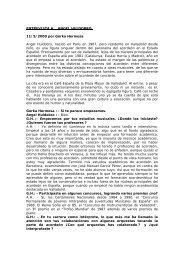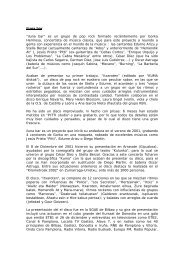The Accordion in the 19th Century - Gorka Hermosa
The Accordion in the 19th Century - Gorka Hermosa
The Accordion in the 19th Century - Gorka Hermosa
You also want an ePaper? Increase the reach of your titles
YUMPU automatically turns print PDFs into web optimized ePapers that Google loves.
Fig. 83: Müller’s method (Vienna, 1834) 156 . Fig. 84: Howe’s method (USA, 1843) 157 .<br />
Leav<strong>in</strong>g methods aside, ano<strong>the</strong>r area <strong>in</strong> which <strong>the</strong> accordion approached <strong>the</strong><br />
classical world was concerts. <strong>The</strong> first accordion concert took place on <strong>the</strong> 8 June 1831<br />
<strong>in</strong> London featured by Johann Sedlatzek (1789-1866), an outstand<strong>in</strong>g flutist at <strong>the</strong> time,<br />
who, at <strong>the</strong> end of one of his recitals, played a piece with <strong>the</strong> accordion, as an encore;<br />
although accord<strong>in</strong>g to <strong>The</strong> Times, <strong>the</strong> <strong>in</strong>strument “however, has little, besides its<br />
novelty, to recommend it”. Apart from <strong>the</strong> unfavorable review, <strong>the</strong> fact that a serious<br />
newspaper like <strong>The</strong> Times noted it, imbues <strong>the</strong> event with significant transcendence,<br />
moreover when a few months before, on <strong>the</strong> 3 rd of March, a short mention of <strong>the</strong><br />
accordion had already appeared <strong>in</strong> this newspaper. [288, 415, 416]<br />
Johann Sedlatzek (1789-1866) 158 was born <strong>in</strong> Glogówek (Silesia, Poland).<br />
S<strong>in</strong>ce his childhood he had shown great musical talent and no <strong>in</strong>terest to take over his<br />
fa<strong>the</strong>r tailor shop, so when Count Franz von Oppersdorff (1778-1818) 159 discovered his<br />
talent and offered to provide for his education, he did not th<strong>in</strong>k twice. At <strong>the</strong> age of 17<br />
he started to play for <strong>the</strong> orchestra of Glogówek’s court, where he met Beethoven. He<br />
left his home town and lived first <strong>in</strong> Opava, <strong>the</strong>n <strong>in</strong> Brno, and later settled <strong>in</strong> Vienna.<br />
<strong>The</strong>re he played <strong>in</strong> <strong>the</strong> Serenadach and s<strong>in</strong>ce 1812 <strong>in</strong> <strong>the</strong> <strong>The</strong>ater an der Wien. In 1818<br />
he started to perform very successful recitals <strong>in</strong> Zurich, Prague, Berl<strong>in</strong>, Rome, Paris and<br />
London, where he married an English woman <strong>in</strong> 1826, and where he eventually settled<br />
his residence. In those years he led an <strong>in</strong>tense musical life as an <strong>in</strong>strumentalist,<br />
composer and concert organizer. In 1842, his wife passed away, after which, he decided<br />
to return to <strong>the</strong> city that had had a stronger <strong>in</strong>fluence on him: Vienna. As a composer he<br />
wrote numerous variations on fashionable <strong>the</strong>mes (one of his best known is Souvenir à<br />
Pagan<strong>in</strong>i for flute and piano, which is still played today), concerts for flute and a large<br />
amount of transcriptions for flute... <strong>in</strong>fluenced by musicians such as Weber, Pagan<strong>in</strong>i,<br />
Moscheles… He was <strong>the</strong> flautist on <strong>the</strong> premiere of Beethoven’s 9 th symphony <strong>in</strong> 1824,<br />
he was one of <strong>the</strong> pioneers <strong>in</strong> us<strong>in</strong>g <strong>the</strong> flute <strong>in</strong> G, he was dedicated some works by<br />
composers such as Kuhlau… “Virtuoso flautist with powerful style” 160 . He often took<br />
part <strong>in</strong> charity concerts organized <strong>in</strong> Vienna by <strong>the</strong> Altonato Women Association, which<br />
reflects his social sensibility. He was said to be <strong>the</strong> life of any party, which might<br />
expla<strong>in</strong> <strong>the</strong> fact that he closed his concert on 8 June 1831 <strong>in</strong>terpret<strong>in</strong>g a piece with a<br />
musical toy like <strong>the</strong> accordion. It is not attested that he played it aga<strong>in</strong> <strong>in</strong> front of an<br />
audience, although <strong>the</strong> fact that such a musical personality played it on stage makes<br />
154<br />
Fig. taken from: Monichon [202] page 39.<br />
155<br />
Fig. taken from: Monichon [202] page 42.<br />
156<br />
Fig. taken from: http://ookaboo.com/o/pictures/picture/12214858/<strong>The</strong>_first_pages_<strong>in</strong>_Adolph_Müllers_accord<br />
157<br />
Fig. taken from: http://openlibrary.org/works/OL1487060W/<strong>The</strong>_complete_preceptor_for_<strong>the</strong>_accordeon<br />
158<br />
Also known as Jean Sedlazek, [127, 238, 283, 414]<br />
159 th th<br />
Count Franz von Oppersdorff (1778-1818), a great lover of music, who commissioned Beethoven his 4 and 5 Symphonies.<br />
[127, 238, 283, 414]<br />
160<br />
Accord<strong>in</strong>g to <strong>The</strong> London literary gazette and journal of belles lettres, arts, sciences, etc of <strong>the</strong> year 1827. [414]<br />
36




